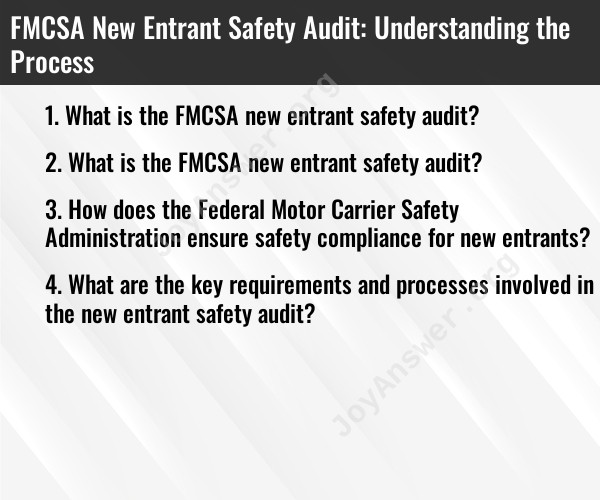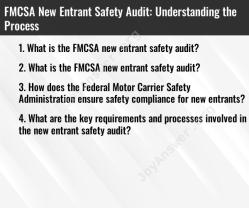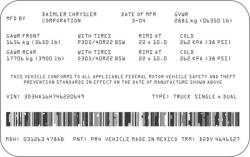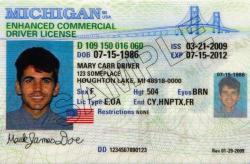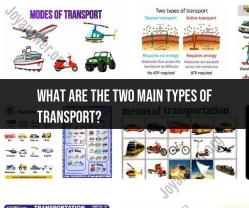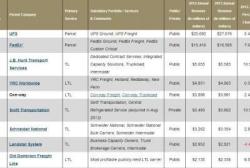What is the FMCSA new entrant safety audit?
The FMCSA (Federal Motor Carrier Safety Administration) new entrant safety audit is a regulatory process designed to assess the safety management practices of newly registered interstate motor carriers and ensure compliance with federal safety regulations.
When a motor carrier applies for operating authority to engage in interstate commerce, they are considered a "new entrant." As part of the registration process, these new entrants must undergo a safety audit conducted by the FMCSA within the first 12 months of operation.
The primary goal of the new entrant safety audit is to evaluate the carrier's compliance with federal safety regulations, including but not limited to:
- Driver qualifications and responsibilities, such as proper licensing, medical certifications, and hours of service compliance.
- Vehicle maintenance and inspection records to ensure the safe operation of commercial motor vehicles.
- Implementation of drug and alcohol testing programs for drivers as required by law.
- Compliance with applicable hazardous materials regulations, if transporting hazardous materials.
- General safety management practices, including record-keeping, training programs, and overall safety culture within the company.
The audit process typically involves a review of documents and records maintained by the carrier, as well as interviews with key personnel responsible for safety management. The FMCSA may also conduct on-site visits to inspect vehicles and facilities.
If deficiencies or violations are found during the audit, the carrier may be subject to enforcement actions, including fines, penalties, and potential suspension or revocation of operating authority. On the other hand, carriers that demonstrate compliance with safety regulations will be allowed to continue operating in interstate commerce.
Overall, the FMCSA new entrant safety audit plays a crucial role in promoting safety within the commercial motor carrier industry by holding new entrants accountable for maintaining high safety standards from the outset of their operations.
FMCSA New Entrant Safety Audit: Ensuring Safety for New Trucking Companies
The Federal Motor Carrier Safety Administration (FMCSA) aims to maintain high safety standards for all commercial motor vehicles (CMVs) on the road. To ensure new entrants to the industry are prepared and prioritize safety, they have established the New Entrant Safety Assurance Program and its cornerstone, the New Entrant Safety Audit.
What is the FMCSA new entrant safety audit?
It's a comprehensive review of a new motor carrier's operations to assess their safety management controls. Conducted by a certified auditor within the first 18 months of operation, it verifies compliance with key safety regulations and record-keeping requirements.
2. How does the FMCSA ensure safety compliance for new entrants?
The FMCSA employs a multi-pronged approach:
- New Entrant Safety Assurance Program: This 18-month program monitors safety performance through:
- Safety Audit: As mentioned above, it assesses safety management controls.
- CSA Monitoring: New entrants participate in the Compliance, Safety, Accountability (CSA) program, receiving scores based on roadside inspections, crashes, and investigations.
- Intervention Strategies: Based on CSA scores and audit findings, the FMCSA may provide guidance, education, or enforcement actions.
- Roadside Inspections: FMCSA inspectors conduct roadside inspections to ensure adherence to safety regulations like driver qualifications, vehicle condition, and hours of service.
3. Key requirements and processes of the new entrant safety audit:
- Documentation review: The auditor examines documents related to:
- Driver qualification files
- Vehicle maintenance records
- Drug and alcohol testing programs
- Safety policies and procedures
- Accident reports and corrective actions
- Interviews: The auditor may interview company personnel like managers, drivers, and safety officers to assess understanding and implementation of safety practices.
- Verification: The auditor may physically inspect vehicles and facilities to confirm compliance with safety regulations.
- **Report and ** The auditor provides a detailed report with findings, recommendations, and deadlines for corrective actions. The FMCSA monitors progress and may conduct follow-up audits.
Remember: Passing the New Entrant Safety Audit is a requirement for obtaining permanent operating authority. By taking this program seriously and prioritizing safety, new entrants can ensure a smooth entry into the industry and contribute to a safer transportation environment.
